

Get Better Mixes in 7 Minutes! [PRO SECRETS REVEALED]
Mix guitars. Mix Bass. 5 Quick Master Bus Mixing Tricks - Warren Huart: Produce Like A Pro. 50 Must-Read Pro Audio Articles from 2014. Another year in the books, another year dodging calls from that Sweetwater rep (yep the adapter still works) — and now, another year-end article roundup on the blog.
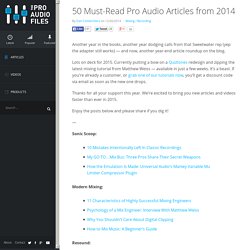
Lots on deck for 2015. Currently putting a bow on a Quiztones redesign and zipping the latest mixing tutorial from Matthew Weiss — available in just a few weeks. It’s a beast. If you’re already a customer, or grab one of our tutorials now, you’ll get a discount code via email as soon as the new one drops. Thanks for all your support this year. Enjoy the posts below and please share if you dig it! Sonic Scoop: 50 Must-Read Pro Audio Articles from 2014. 5 Production Secrets of The Beatles. Widely regarded as one of the greatest and most influential bands in the history of popular music, there is plenty of available literature on the techniques and equipment used to record The Fab Four, including my personal favorite Recording The Beatles by Brian Kehew and Kevin Ryan.
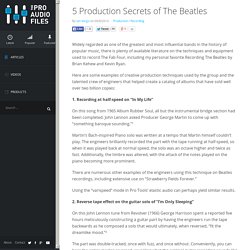
Here are some examples of creative production techniques used by the group and the talented crew of engineers that helped create a catalog of albums that have sold well over two billion copies: 1. Recording at half-speed on “In My Life” On this song from 1965 Album Rubber Soul, all but the instrumental bridge section had been completed.
John Lennon asked Producer George Martin to come up with “something baroque sounding.”¹ Martin’s Bach-inspired Piano solo was written at a tempo that Martin himself couldn’t play. There are numerous other examples of the engineers using this technique on Beatles recordings, including extensive use on “Strawberry Fields Forever.” 2. 3. 4. MICK GUZAUSKI - MIXING WITH ANTELOPE ORION32 HD AND FPGA FX. The Low End Mix Trick - TheRecordingRevolution.com.
Compression. EQ. 5 Favorite Mix Buss Plugins - Into The Lair # 114. eContact! 9.3 - Contemporary Problems, Interventions and Results - II. Communauté électroacoustique canadienne Canadian Electroacoustic Community GM-500 — 1455, boulevard De Maisonneuve Ouest Montréal, QC — H3G 1M8 Canada – cec@sonus.ca by Dominique Bassal [English Abstract] See preceding section: 3.
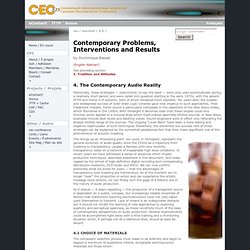
Tradition and Attitudes 4. Historically, these strategies — reductionist, to say the least — were only used systematically during a relatively short period, and were called into question starting in the early 1970s, with the advent of FM and home hi-fi systems, both of which rendered them obsolete. This brings up an interesting point: we could, in retrospect, represent the general evolution of audio quality since the 1950s as a trajectory from masking to transparency. As it stands — it bears repeating — the production of a transparent sound is dependent on a subtle, complex, but increasingly reliable ensemble of factors that institutions teaching electroacoustics have not (yet) taken upon themselves to transmit. 4.1 Choice of Materials Audio 1. Audio 2. Audio 3. Blue Bear Sound - ARTICLES.
There they are...8/16/24/48/96 tracks that you’ve painstakingly recorded, overdubbed, erased, and recorded some more.... so now what? You can’t play with your mixer’s knobs every time you want to hear your masterpiece! You need to blend all those tracks to (usually) a 2-channel, stereo mix. In other words, mixdown your tracks. Great --- so what does THAT mean? HOLM Acoustics. News. Pensado's Place - Learn how to produce, record, mix, and master music and audio. eContact! 9.3 - Contemporary Problems, Interventions and Results - II. Metering. Audio metering is one of the most confusing and complex aspects of sound recording.
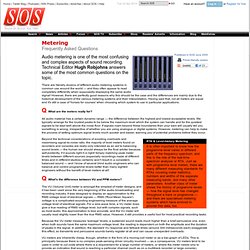
Technical Editor Hugh Robjohns answers some of the most common questions on the topic. There are literally dozens of different audio metering systems in common use around the world — and they often appear to read completely differently when supposedly displaying the same audio signal! However, there are perfectly good reasons why this should be the case and the differences are mainly due to the historical development of the various metering systems and their interpretation.
Having said that, not all meters are equal and it's still a case of 'horses for courses' when choosing which system to use in particular applications. Q What are the meters really for? All audio material has a certain dynamic range — the difference between the highest and lowest acceptable levels. Audio and production tutorials, from beginner to advanced. Media Converter - the fastest free online audio and video converter. Mastering. Guide to Mastering Your Own Music v2.0 October 24th, 2011 By Tarekith Preface: The original version of this mastering guide was by far the most downloaded and shared production guide I've ever written, even though it was primarily geared towards "beginner" musicians.
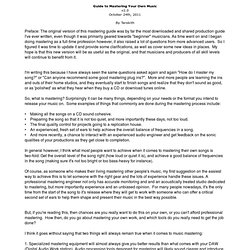
As time went on and I began doing mastering as a full-time profession however, it also raised a lot of questions from more advanced users. So I figured it was time to update it and provide some clarifications, as well as cover some new ideas in places.